Nov 16, 2016 | interviews, painting
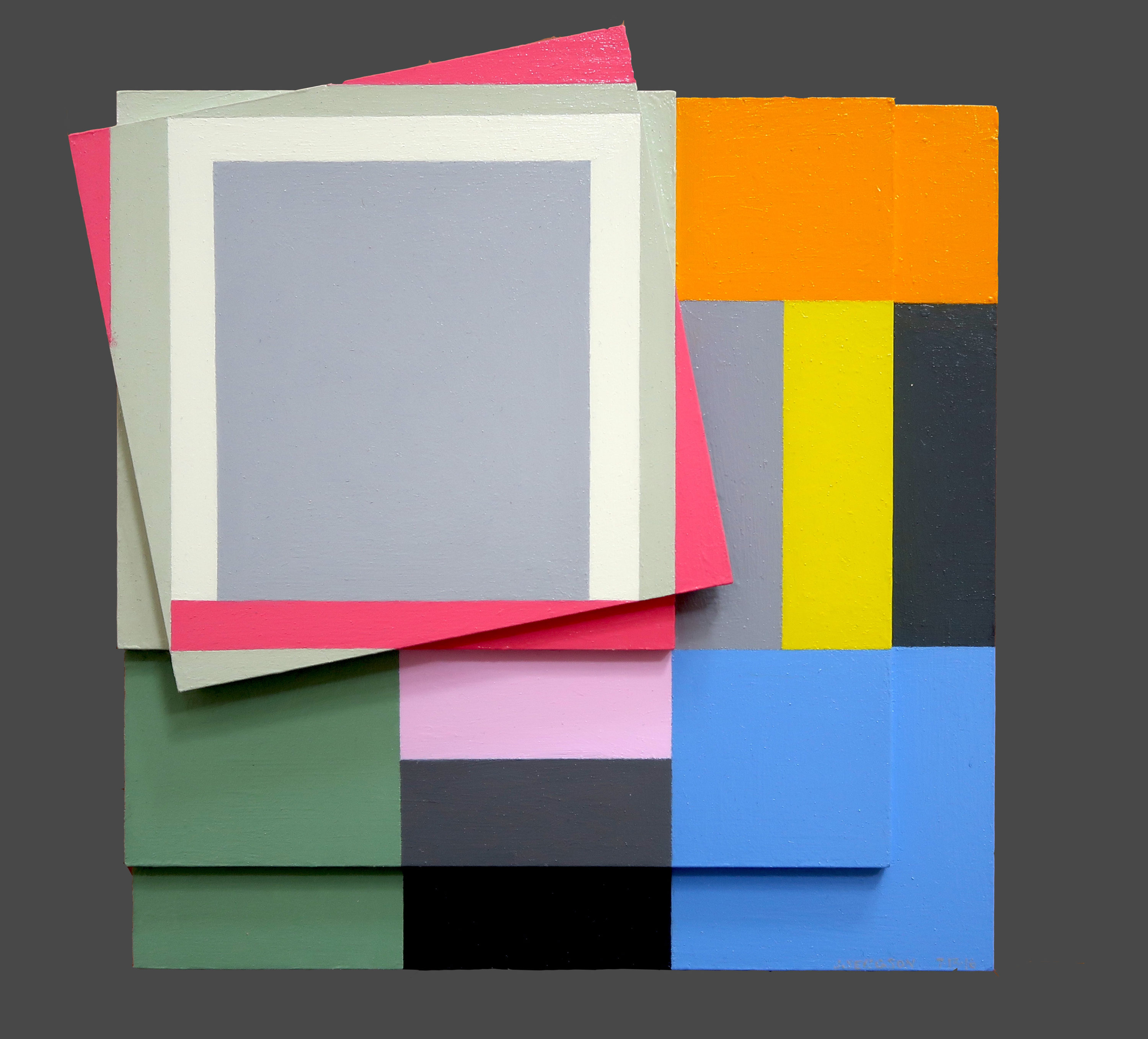
Judith Seligson
Signs Of Struggle, 2016
Oil on panels
8.5 x 8.5 in.
Courtesy of the artist
Colors fracture, shapes surface, and together the two work in tandem to continue Josef Albers’ exploration of minimalist, geometric compositions. Judith Seligson’s new exhibition Drawing the Line is comprised of elegant, cheerful examples of shape and color getting well acquainted.
How did you begin in geometric painting? What was the initial spark of inspiration for you?
I developed a series of charcoal drawings in my first studio, in Cambridge, MA in 1973, just after I graduated from Harvard, that presaged everything that was to come. I was drawing from life; both the studio itself and a vase of my mother’s dead roses were my subjects. Despite charcoal’s propensity for infinite shades of gray, I found myself using the charcoal simply to outline discrete empty shapes. Each petal surface was a shape. This method flattened objects and made them of a piece with everything else in the work, like tesserae in a mosaic.
At that time, too, I was studying a book called Cézanne’s Composition: Analysis of His Form with Diagrams and Photographs of His Motifs by Erle Loran. He “reduced” a painting to a series of lines of force. I began applying this method to some of my favorite Vermeers. Vermeer too focused my attention on drawing architecture.
My love of building blocks and of finding hidden structures in a painting and in life continued to grow and develop. Still, I pushed against it then and still do. In 1978 I had a show of painting pairs – each pair used the same palette, but one was geometric and one expressionist. I ended up pursuing the geometric direction, thinking that I could always pull the expressionist one off the back burner if I needed a change. When I look at those small painting pairs now, I find the expressionist ones much better than the geometric ones.
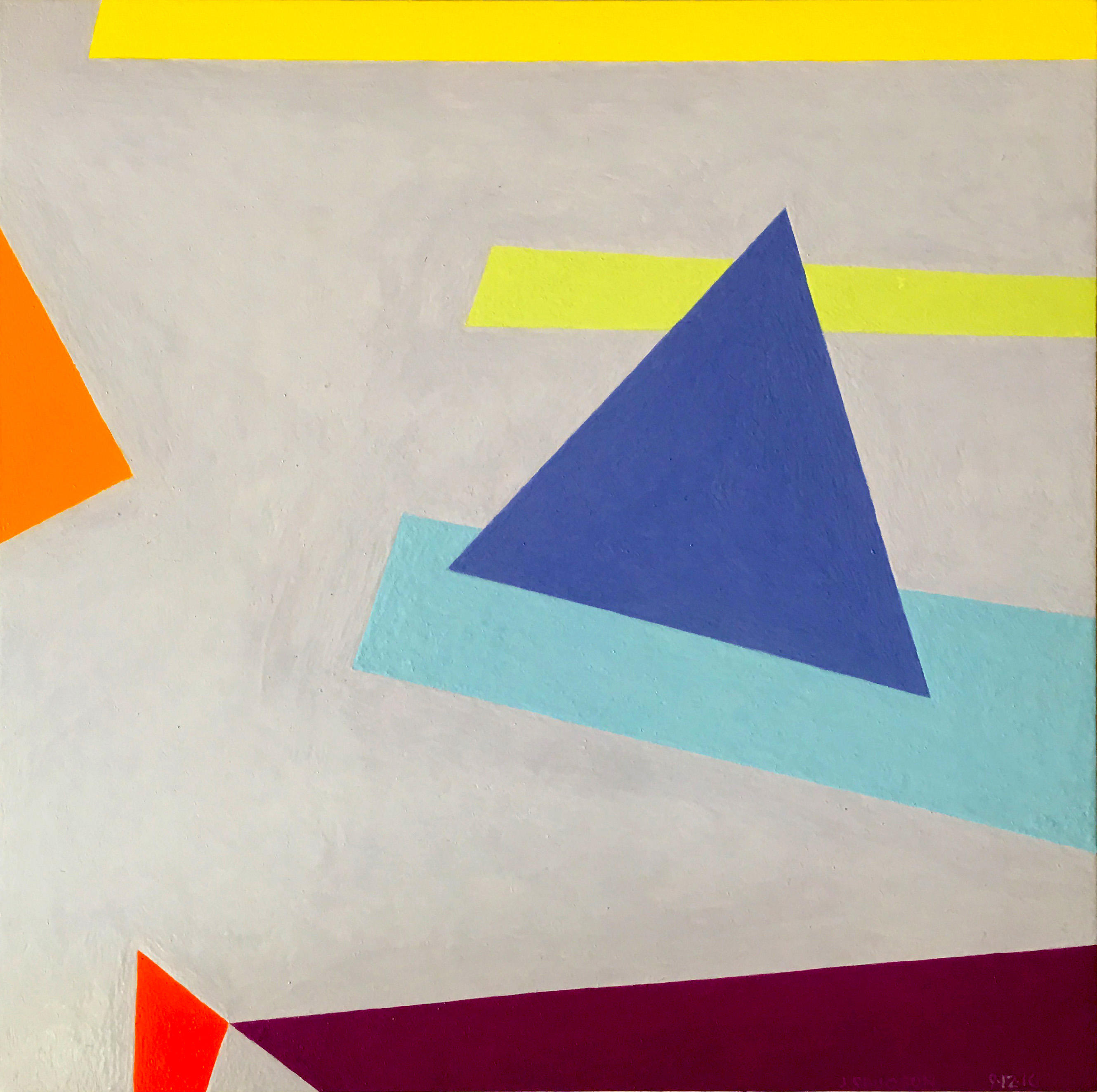
Judith Seligson
Golden, 2016
Oil on panel
7 x 7 in.
Courtesy of the artist
Galérie Mourlot describes your work as having a “feminist bent.” In what ways do you see your work as uniquely feminist?
Here is a quote from my article, Contrapuntal Painting, which appeared in the Radcliffe Quarterly, March 1992:
“Many of my paintings are diminutive, intimate, three to five inches in either direction. Rather than physically overpowering (as many men are to women), they suggest a more interactive relationship with the viewer. Smallness in art may be coming under a more favorable star, but in my lifetime size has mostly been a directly proportional measure of importance and, though no one would admit it, quality. The small works are painted on paper. Arthur Danto has aptly pointed out that paper, since it is so expendable, is considered a less “serious” medium than canvas, panels, or walls, and so has become associated with the artist’s “intimate moods.”
“Paper and women have a lot in common in that they both have developed a reputation for being less than serious but good for intimate moods, and maybe even expendable. I take these stereotypes, these preconceptions, and play with them. I draw on the bare paper — actually four-ply museum board — and then apply multiple layers of a gesso wash to protect the painting from the board. This way I can be serious, intimate, expendable, and conservable all at once.”
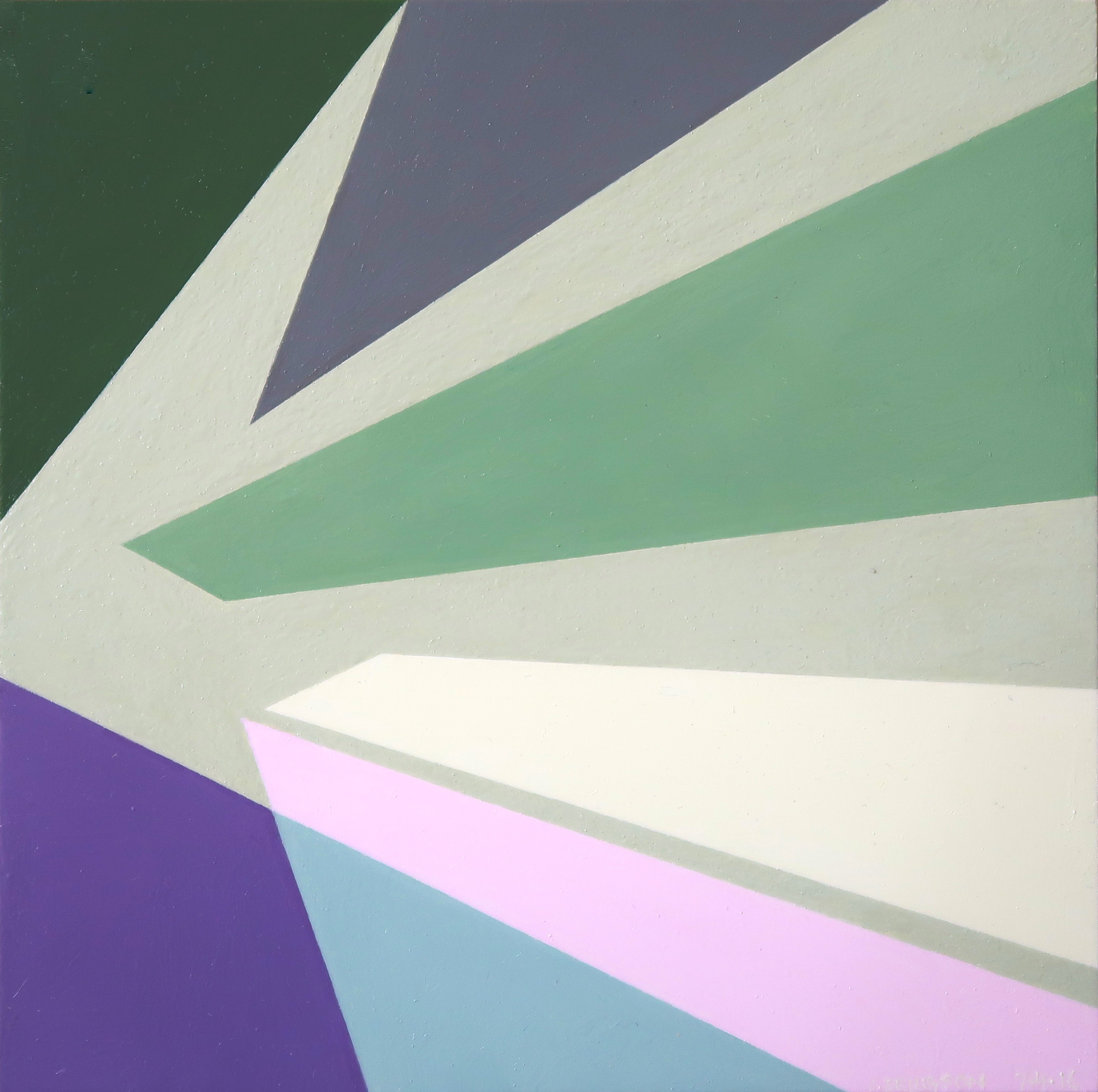
Judith Seligson
Healing Brush, 2016
Oil on panel
6 x 6 in.
Courtesy of the artist
When did you first introduce three-dimensionality to your work?
About four years ago. I was making a series of collages using, among other things, fragments of my own paintings. These were works I didn’t love or didn’t think were finished, but couldn’t toss. Then I started placing paintings that I had signed into a single composition. That led to adjusting one or the other to improve the composition. Then I started gluing together completely blank panels. At that point, I didn’t know how I wanted to paint them. I looked at them for over two years until I figured out the topological painting in Fine Tuned.
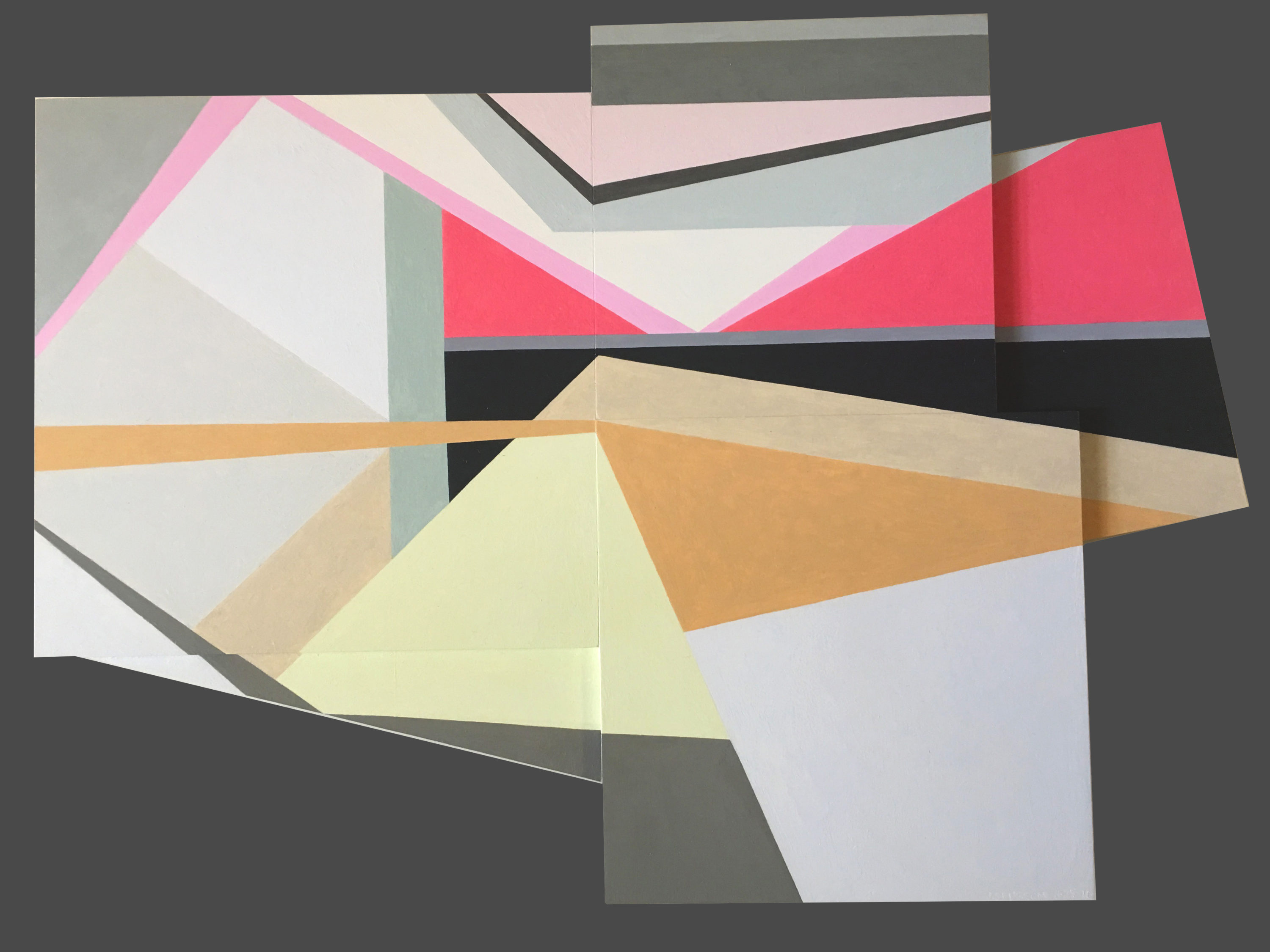
Judith Seligson
Complications, 2016
Oil on panel
11 x 16 in.
Courtesy of the artist
Can you walk us through the process of creating one of your works? Which comes first, color or shape?
The chicken or the egg. Each painting begins with a graphite line drawing. Usually, I draw directly on the painting surface. Sometimes, I trace a drawing onto a panel, or enlarge a small drawing onto a larger surface. I draw and erase until I see the blank shapes pushing and pulling, à la Hans Hoffman, moving in the shallow 3-D illusionary space created by an interplay of color and form.
I then apply several layers of thinned gesso, sanding between layers, to get a very smooth surface. The drawing is still visible, but the graphite will not mix with the paint.
Positive shapes, like a vase, will appear in front of a negative shape, like the shape around the vase. Matisse said that painting begins when you can see both the vase and the space around it at the same time. Warm reds push forward, blues recede. I work each against the other so that the color shapes are pushing and pulling my eye around the surface in what I call I visual melody. I will use a cool color to push back a shape that appears too forward, or a warmer color to pull forward a shape that is receding. Like a great song, a visual melody is a whole structured by notes, tempo, dynamics, and a sense of beauty – or is it pleasure? Each shape is a note in several simultaneous visual melodies, playing on the scales of hue, tone, temperature, intensity, and negative/positive shape. I have called my work Contrapuntal Painting, in that counterpoint in music is created by two or more melodies played simultaneously. Each is both an independent melody and also the harmony to the other.
In this sense, too, my work is feminist. Man and woman can be the counterpoint to each other, rather than the woman traditionally being only the harmony to the man’s melody.
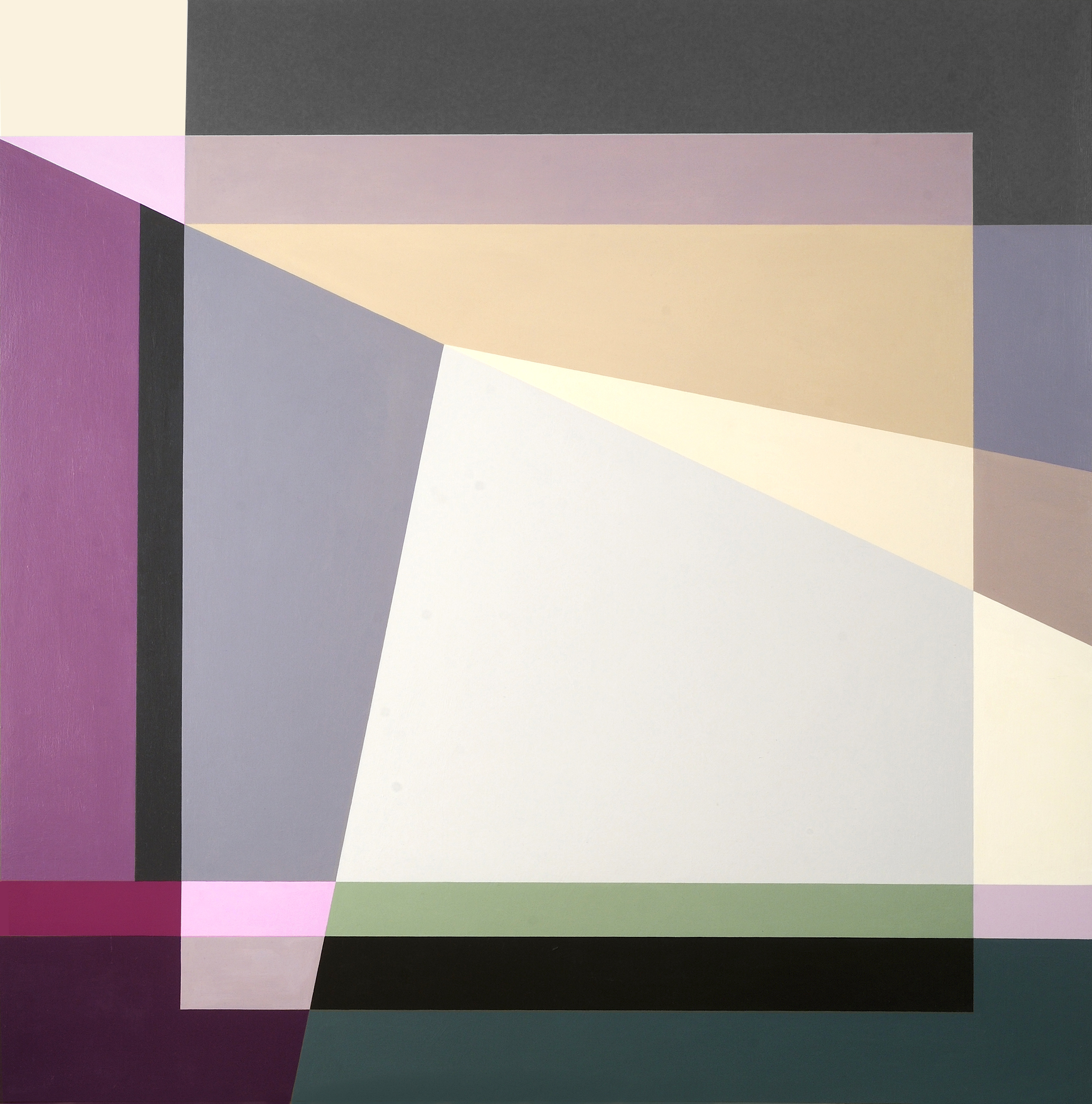
Judith Seligson
Self Portrait, 2014
Oil on panel
36 x 36 x 2 in.
Courtesy of the artist
Which artists or websites do you most often find yourself looking towards for inspiration?
I look to many of the Dutch painters – Rembrandt, Vermeer, Mondrian, and de Kooning. Their devotion to structure and to light in a painting is a constant inspiration.
I like Elizabeth Peyton’s small portraits and Cecily Brown’s paint handling. I like Peter Halley’s electrical circuit paintings. I look at and read Artforum and Bookforum in print. Intermittently, I read artnet News, Hyperallergic, and Blouin Artinfo.
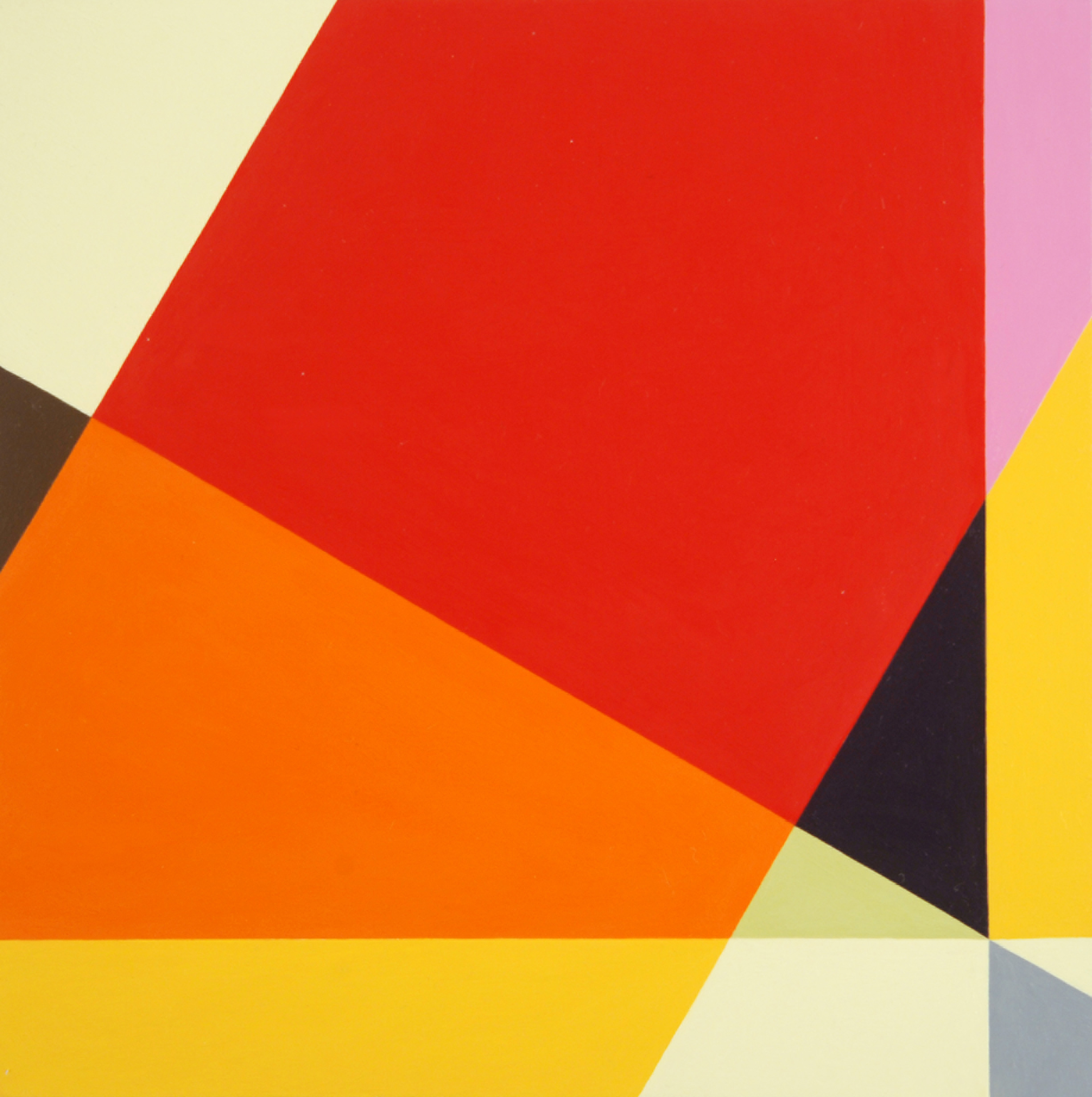
Judith Seligson
Candy, 2008
Unique digital painting on canvas
43 x 43 in.
Courtesy of the artist
Drawing the Line opens tomorrow, November 17 at Galerie Mourlot on 79th Street in Manhattan where it will remain on view through January 9, 2017.
Sep 2, 2014 | happenings, interviews, London, sculpture
If you live in London, this post is for you! An incredible contemporary sculptor is opening a new solo show titled gleam at Kristin Hjellegjerde Gallery next Thursday, September 11th.
Richard Stone‘s sculpture morphs art historical motifs into relatable figures, creating a new image from repurposed contexts using antique media like bronze and marble.
The artist is most interested in abstracting and breaking down contemporary representations of universal ideas that might be found more easily in painting and photography but not so much in sculpture:
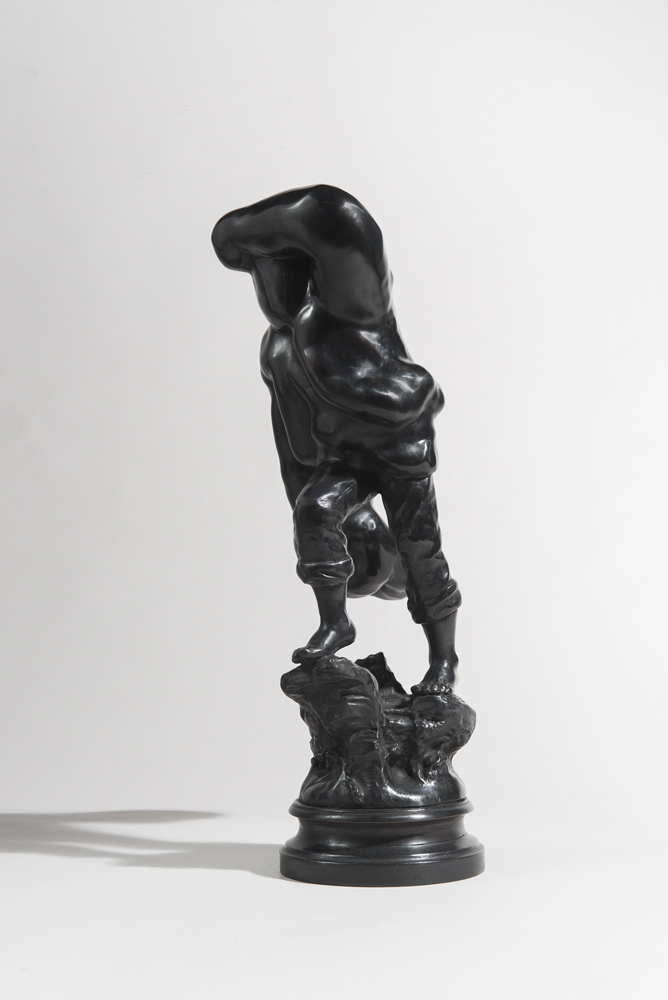
“the rescuer,” 2014
bronze, patina
approx 57x23x23cm
How has your process of molding and sculpting works changed as your art has developed?
I’ve started to find a new and more focused language in bronze and marble, working more directly with preparatory wax models, that has opened up many more possibilities.
I’ve long been interested in how I can recast classical themes in contemporary light and these materials are enabling me to do that, not least because, in essence, they’re such beautiful, beguiling materials, ancient in origin, but utterly contemporary and limitless in scope.
When did you first begin experimenting with the abstracted human form in three dimensions, and why?
It really started with looking to describe and make physical, the space around existing figurative objects, often in heroic poses, applying layers of wax to create an amorphous, contrasting form.
This not only enabled me to evoke a duality of form and material, but importantly, to think through the idea of representation and it’s conventions, more keenly, exploring the increasingly contemporary point at which representation begin to blur, dissolve or fall apart.
What is it that usually sparks the initial idea for a new sculpture?
It can be anything, visual or literary, historical or contemporary, a found object, a work of art, a place, but quite often a line from a book or poem.
What do you hope your work communicates to the viewer?
I think any intention on the part of the artist has to remain open, but the hope is always that the work is resonant enough to meet people where they are, in that moment, or be powerful enough to form a memory.
Which part of your upcoming September show are you most excited about?
For me, these works represent years of thinking and making, but it’s really now, that they’ve come together, in the form and mediums that best express them. The classical materials I’ve returned too have been updated and for me, represent a much stronger visual and contextual statement.
The exhibition in that sense is both a consolidation as well as a departure, I would say it’s a new statement of artistic intent.
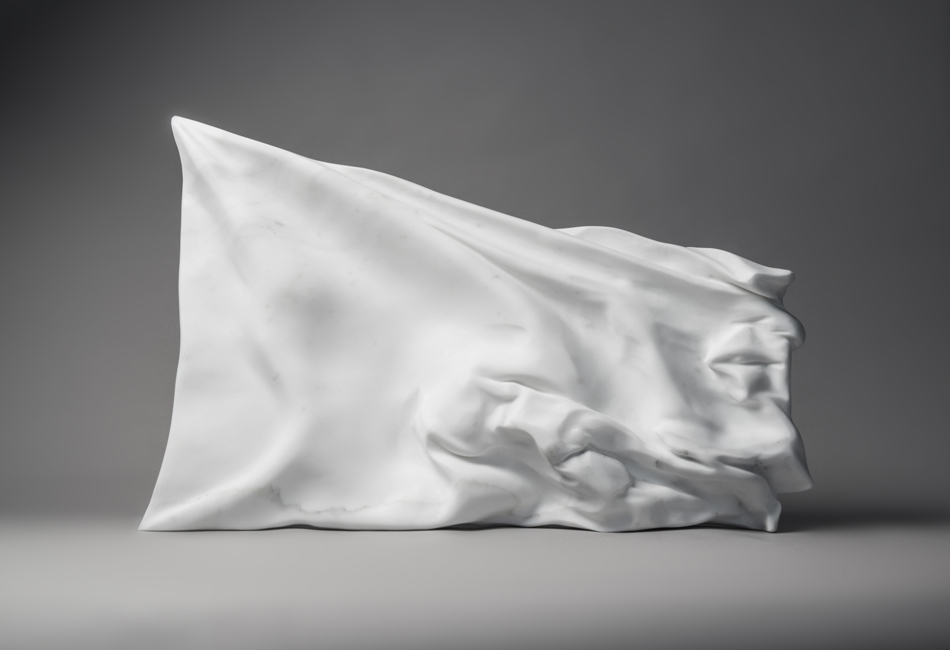
“only in the ruins will you be free,” 2014
statuario marble
approx 91x57x10cm
Richard’s show at Kristin Hjellegjerde Gallery will be on view until October 12th.
Interested in going to the opening? Find the details here.
And see more of Richard’s work on his website and Twitter feed.
Apr 6, 2014 | collage, interviews, painting
Pascal Janssen‘s talent for creating faces makes it hard to believe he’s just 21 years old. The Belgian artist paints, draws and collages features with so much emotion in them, each face nearly breathes with life.
He mostly draws portraits of his friends, occasionally including a favorite musician. He captures those moments of revelation and self-doubt as each new set of eyebrows and chins depict them, emphasizing each subtlety to reveal a depiction truer than a photograph.
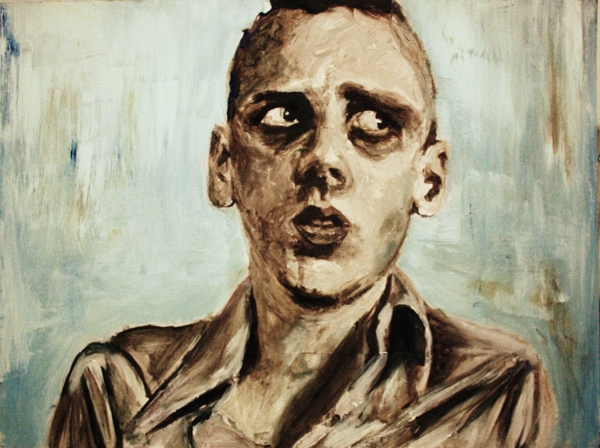
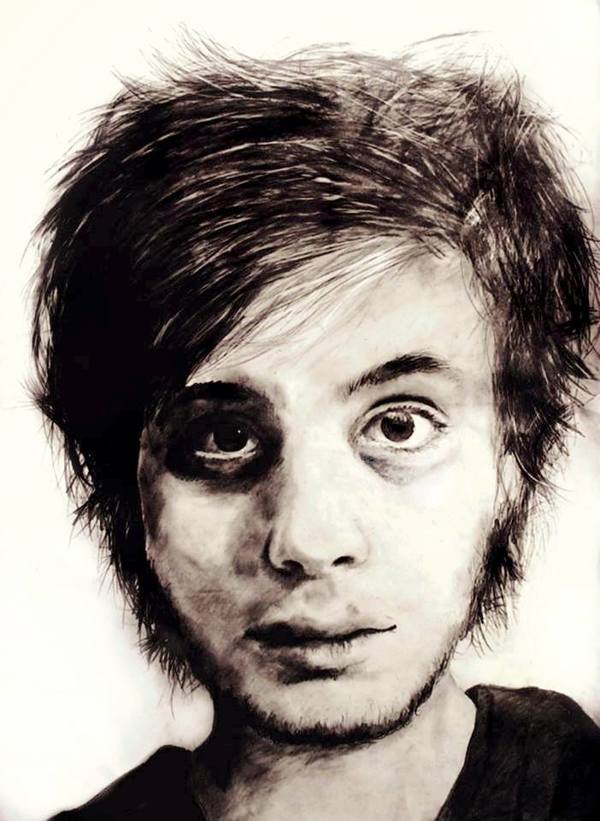
“My artwork is mostly based on the mind of the human being, how it’s perception on the world and itself is,” he writes.
Drugs and their affects also played a role in the formation of his work. Pascal seems fascinated by the changes drugs cause within the body, and how those changes manifest themselves in expressions.
Pascal was nice enough to answer my questions about his work, and how his fixation on the face began:
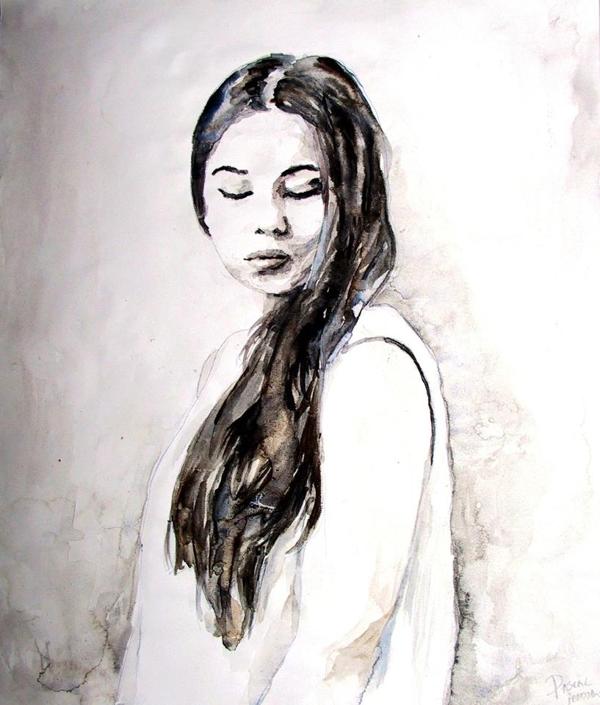
How has living in Belgium helped shape your art? What do you like most about Hasselt?
Even though art in Europe is more active in Berlin, Belgium is also a nice place for an artist. You have a lot of art schools around the country. My parents sent me to art classes since I was in kindergarden, it was once a week and just for fun.
I quit those art classes when I went to high school in Hasselt where I did visual arts. I really loved it there and had a great time, the people there were a lot more open minded than they were in middle school. I really hated middle school, some teachers even mocked me for planning to go to art school.
But I couldn’t care less, I always wanted to be an artist. And for now I’m studying at an art college, just next to my high school. I’ve always loved Hasselt. It’s not the most interesting place in Belgium like Gent, Antwerp or Brussels. But I do feel safe there, it feels like home. I currently live at Rekem, close to the border of the Netherlands where Maastricht is located. Maastricht is also a nice place for an artist, I had my first exhibition there with 7 other artists in September 2013 and planning to have my first solo exhibition there in April 2014.
When did you first start creating portraits? Can you remember the first person you ever painted?
I don’t really remember, I probably had some assignments to paint or drew a portrait for school, but didn’t care about it cause I mostly just made what I felt like making. When I was in elementary school I drew a lot of cartoons but when I went to high school I mostly painted abstract paintings and when I was around 17 I really noticed I just love painting portraits.
And that was when I created “Ignorance is Bliss.” It’s a portrait of some stoner, to this day I still don’t know who this guy is but I thought it was kinda hilarious to paint him because my teachers back then hated anything that had something to do with drugs. Most of my work back then had references to drugs and sometimes it still does, because I still think it has some interesting factors like hallucinations, psychoses, addiction, depersonalisation, etc. I think making portraits is something I’ll always will love doing, but I’m always open to paint new things or use new techniques. I like to experiment a lot.
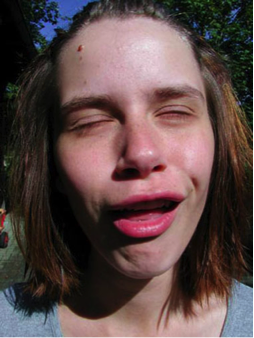
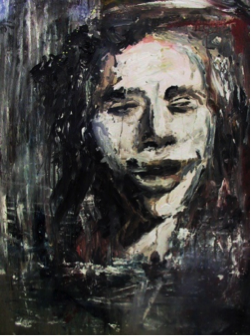
What do you love about reinterpreting the human face over and over again?
I never thought about that really, for me it’s more than just a face. It’s like I’m painting a complete person as he or she is, or just how I feel about them. I like painting my favorite musicians. Mostly musicians who make lyrics which reflect the thoughts and feelings in my life, like King Krule, I love the melancholy in his music. But I mostly love to paint my friends, like I said it’s more then just a face.
How long does it usually take to create each of your works, and what methods do you use to create them?
I mostly work in a fast tempo, it takes normally about an hour or 2, depending on size of course. And if I start working on a piece, I don’t stop untill it’s finished or else I just start all over again. I learned to paint this fast because I work a lot with watercolor. With that kind of paint you have to work fast and you cannot really correct mistakes.
My technique with watercolor also had an effect on my technique with painting in oil. I use a lot of terpentine on my oil paintings just like I use a lot of water on my watercolor paintings. I also don’t use white oil paint, instead I use gesso, a thick paint you actually use for preparation of your canvas. I never really liked working traditionally I guess.
What’s one of your favorite quotes about art and how do you see it applying to your own work?
The quotes of Vincent van Gogh are my favorites, they might sound cheesy but I love them: ” If you hear a voice within you say ‘you cannot paint,’ then by all means paint, and that voice will be silenced.” Criticism has always motivated me even if it came from within me. I’m not trying to be a better artist then somebody else, I’m just try to be better than myself.
“I feel that there is nothing more artistic than to love.” As the romantic person I am, love has always motivated me to paint.
“I know nothing with any certainty, but the sight of stars make me dream.” I’m also a very agnostic person who will question about anything, but I do have an endless fascination for the universe.
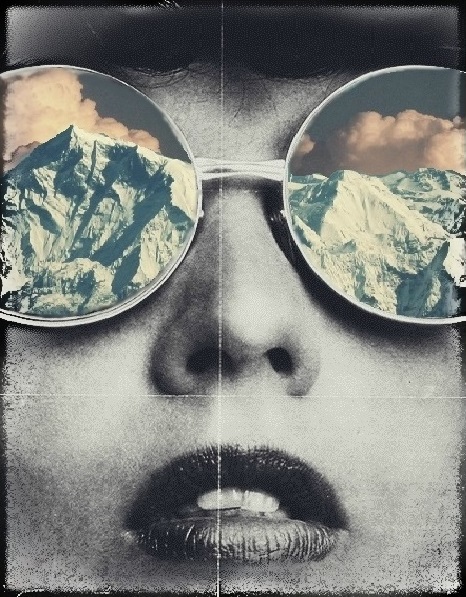
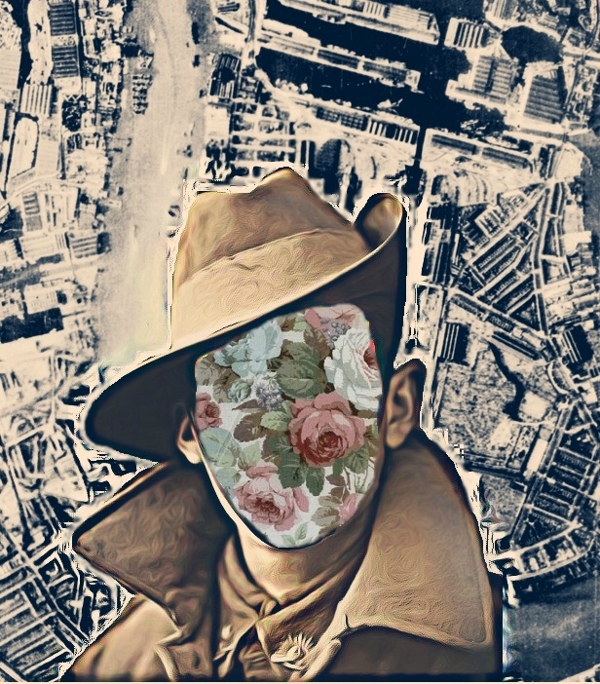
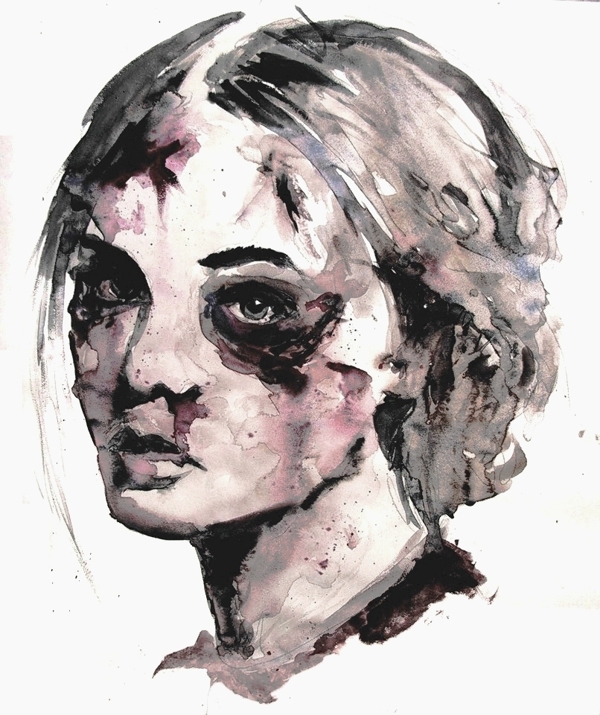
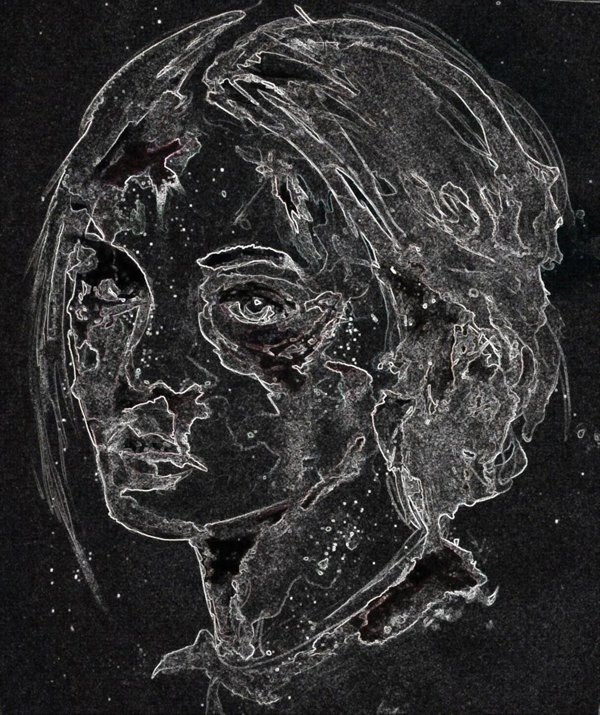
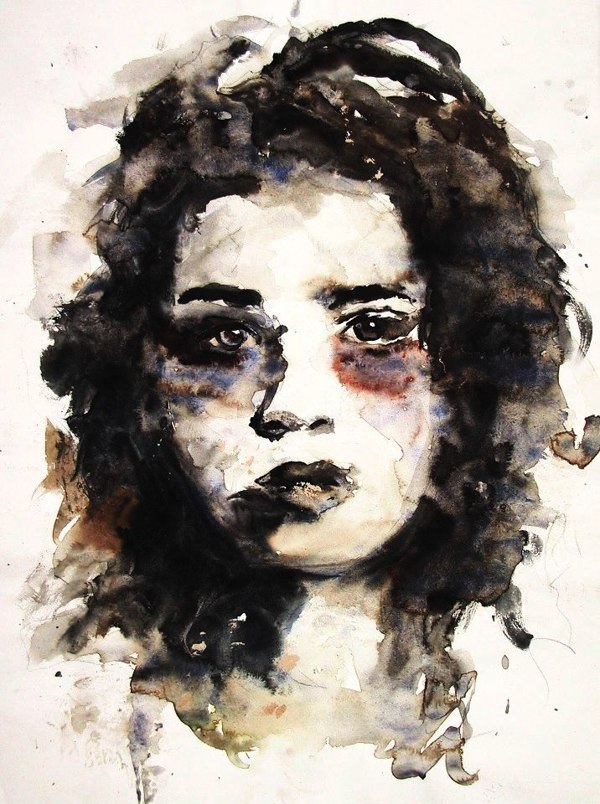
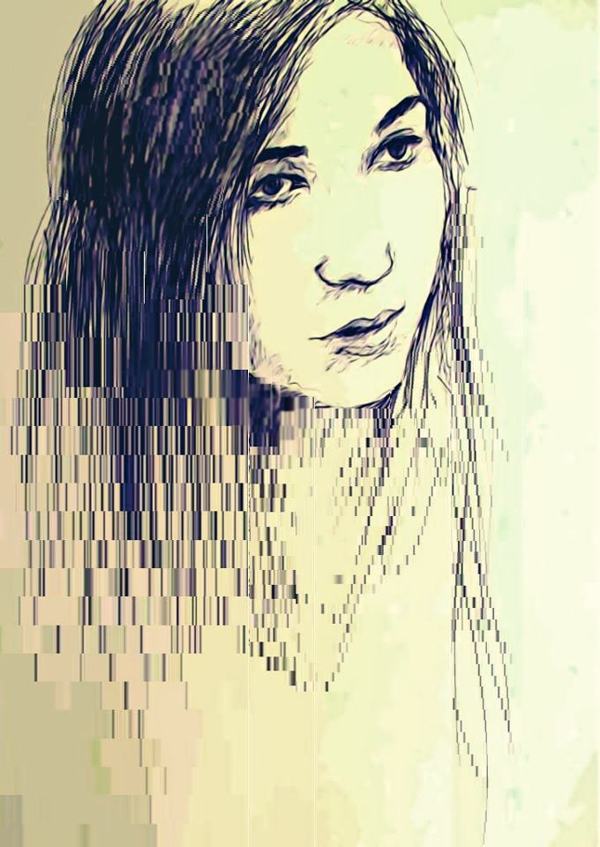
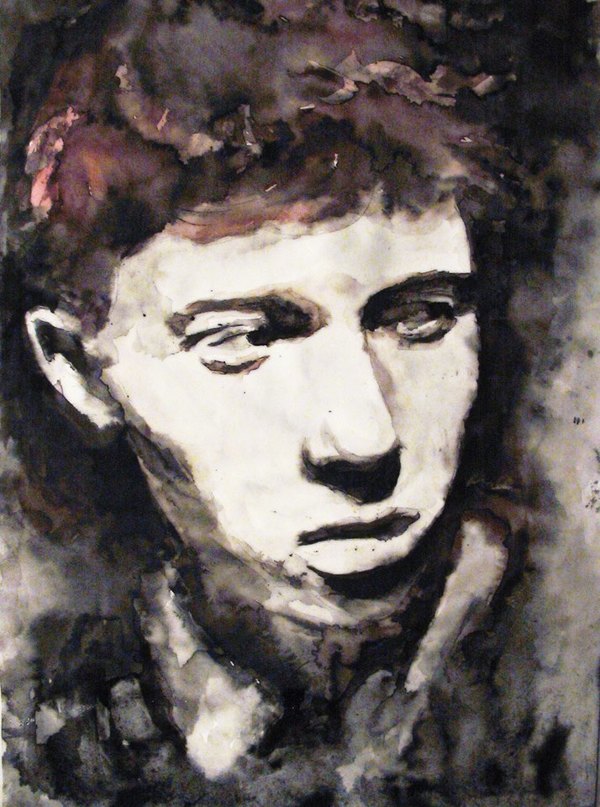
For more from Pascal, you can find him on Facebook, Tumblr and Behance.
Jan 28, 2014 | art history, interviews, sculpture
An artist from Athens, Greece, Teodosio Sectio Aurea paints with shadows, using sculpture and light to recreate masterpieces in negative space. He takes us through a tour of art history using different types of sculpture to match each shadow — thick black metal for “Guernica,” a cherry blossom tree forms a woman in “Akina – spring flower,” and DNA beads form the “Vitruvian Man.”
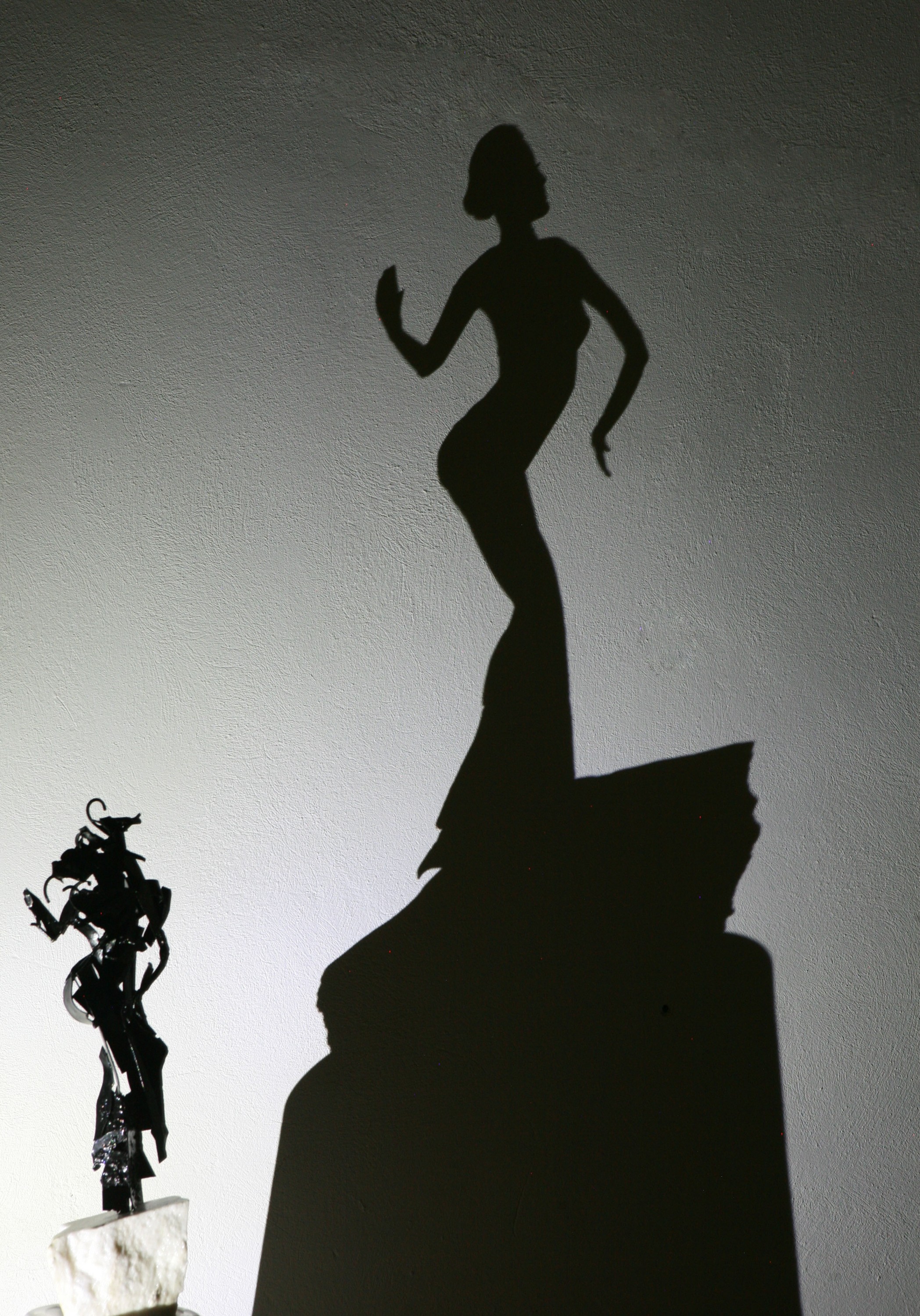
How does living in Athens affect your art?
I am not an Athenian or a Greek, but a citizen of the world. Socrates, from Plutarch said Greece is the most beautiful places on Earth.
When did you first start experimenting with shadow art?
I started my shadows one year ago, I just sort of ”woke up” you know?
How long does it typically take you to work with the negative space?
Some shadows are difficult, but nothing is impossible.
What’s one of your favorite quotes about art?
“In art we trust.”
Who’s are a few of your art idols?
Dali, Pollock, Kandinsky, Da Vinci, and again Dali :)))))




For more of Teodosio Sectio Aurea’s work, see his website and Facebook page.
Dec 12, 2013 | collage, interviews
Gabriel Folli is a young French artist, working in nearly every medium to interpret his memories and the world around him. He’s studied at the University of Amiens, near Paris since 2009 and has exhibited in Amiens, Abbeville and Bourges, France this year.
His collaged works are my favorite — layer upon layer of photographs and color that turn memories into dreams — or nightmares, depending on what frightens you. But his portfolio finds balance in representational paintings and drawings of landscapes. They hold shadowed horizons taken from photographs, and the sheets of skyline can be rearranged and randomized to create places that don’t exist.
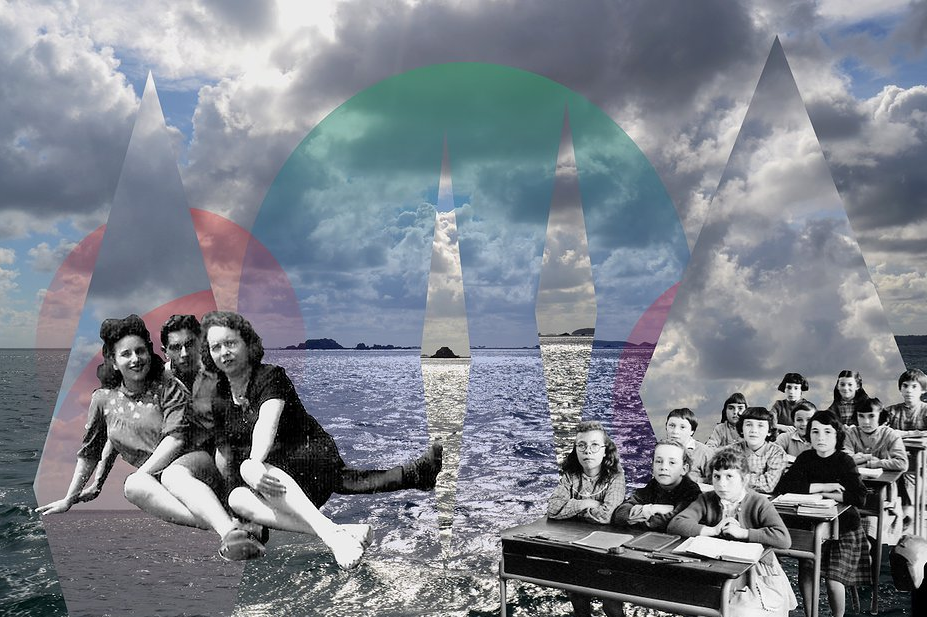
When did you first know you wanted to be an artist? What’s the first artwork you can remember ever creating?
I began to draw comic strips when I was 13 or 14 years old. I wanted to make it my job. During the high school I created many drawings and installations… Concerning the works I make today, the first work which had an influence on the others was a video called Open Door, created in 2012.
Where do you find the images for your collages? How do you piece them together?
Initially, I take photos of landscapes which make up the background of the collage. Then, the characters are members of my family, my friends…I find theses photos in my family’s archives, most of them are old photos that come from the house of my grandparents. I give them a second life.
For the construction of collages, I look for people who can correspond to the landscape, or not, and I play with the hot colors. In my work in general, there is a strong contrast between warm colors, light and the black of darkness. I want to create idealized and fantasized situations in my collages.
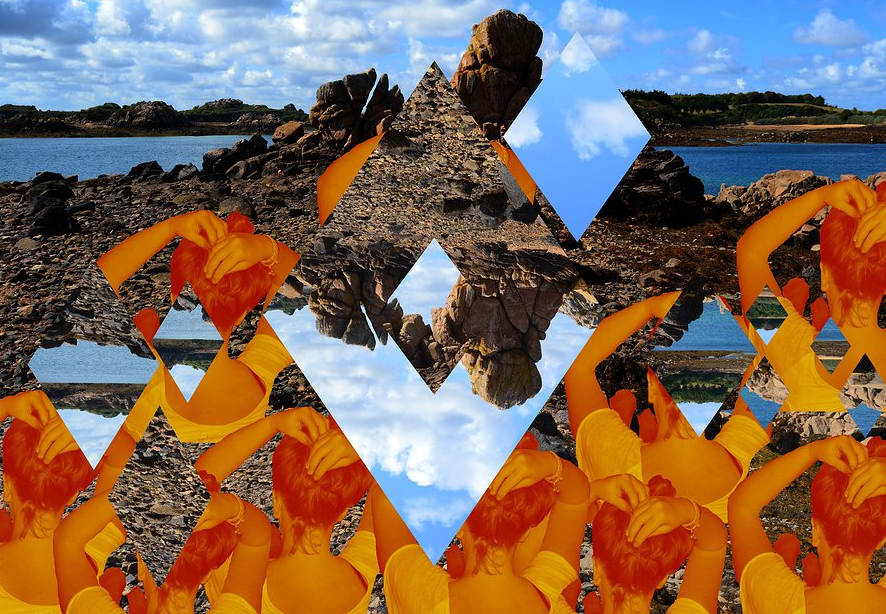
Do you create your drawings from photographs? What about landscapes inspire you to depict them in so many different ways?
Yeah, my drawings are created from photographs. Photography (or video) is often the basis of my work. I use photos to create drawings, paintings, collages…
The photography is not really the purpose but a way. Every drawing corresponds to a memory, and all of theses drawings create a life, my life, in which the memories are mixed and modified with time. Drawings are put on a same horizon line, in a random choice, and form a unique landscape.
Who are a few of your art idols, and do you think they played a role in the formation of your own work?
A lot of artists are influence my work, it’s certain! I discover most of these artists on the Internet or in books, among whom many are not very well-known. I like the work of Monika Traikov, Fabienne Rivory, Sergey Larenkov, Lorna Simpson or Alexander Schellow, one of my favorite artists. Each of them has a different approach, and in my work, I try to find new techniques to realize my memories, and at the same time, destroy them.
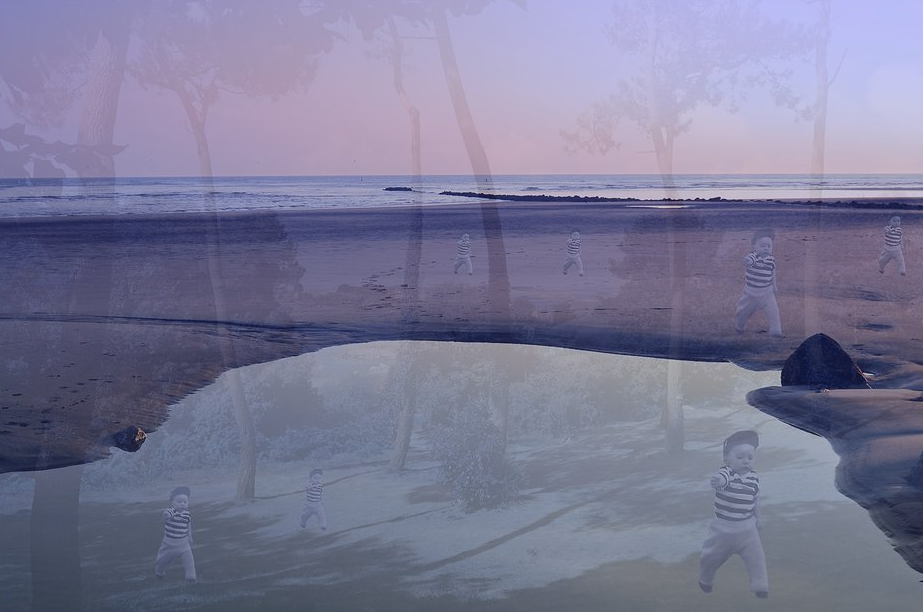
Which places most inspire you to create your landscape works?
I like the nature more than the city. A lot of my photographs are taken in the nature, in front of the sea or forest. I am interested by the night too. The night brings me a lot of contemplation, silence, solitude. Besides, I often create during the night.
What’s one of your favorite quotes about art?
« Je composerai jusqu’à la décomposition. » Serge Gainsbourg
In English : “I shall compose until the decomposition”
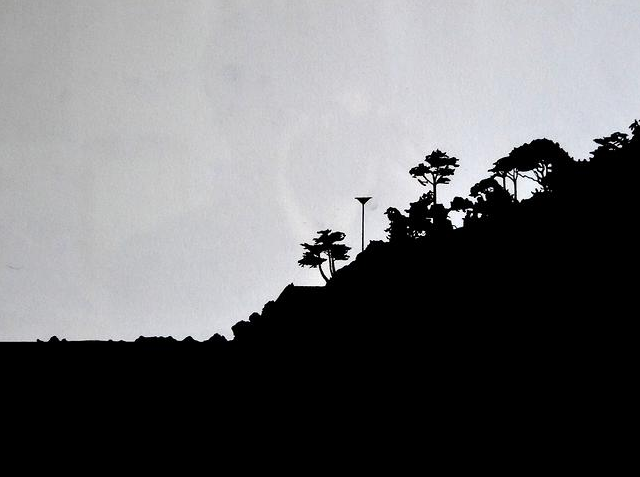

For more from Gabriel, check out his Twitter, Tumblr and website.
Oct 24, 2013 | interviews, painting
Ilaria Berenice is an Italian artist who uses color and loose forms to express herself on paper. Her works keep their wet, fluid feel even though the paint has long been dry. Every stroke looks intentional and spontaneous all at once, and the bright colors she uses brings every shape and form to life. She studied anthropology and ethnology at the University of Siena, but didn’t begin painting until traveling through Brazil, Italy and Spain in the early 2000s.
Now, her work has has been exhibited all over Italy and featured in multiple publications including the Spanish critic Eva Minguet Camara’s 2008 book “Ilustraciòn de vanguardia” (“Art illustration”). This past summer Ilaria had a solo exhibition at one of the biggest castles in Europe, at Castel Brando, between Venice and the Dolomites.
When you sit down to complete a portrait, do you already have an idea of how realistic you want to convey the sitter?
When I started to make committed portraits with oil, the goal was to make them as realistic as possible. But when I make them with mixed media, I just catch the glimpse of the soul and personality of the person, or just an aspect, while playing and having fun with the sign between shadows and lights, and strangely enough they look more familiar with the sitter than the realistic ones, to me.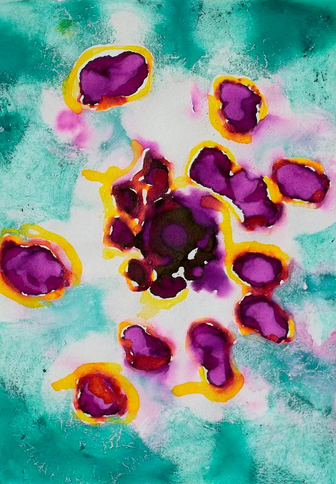
You write that your collection of “Visionary” work is inspired by momentary situations and ideas. Can you tell us the story behind your mixed media work “Venice”?
I love the work “Venice,” overall because is the latest one. Well I just played with stains of blue and green, made of pigments, glue and water, then I let the work on the easel appear whatever. The day after I saw Venice on it, I just allowed what I saw to come out.
What do you use for reference in your anatomy drawings?
I did them last winter at the Brera academy here in Milan where there is a real skeleton. While for the muscles I used pictures, and for the people I used real people, all in the class of the artist and professor Maria Tcholakova.
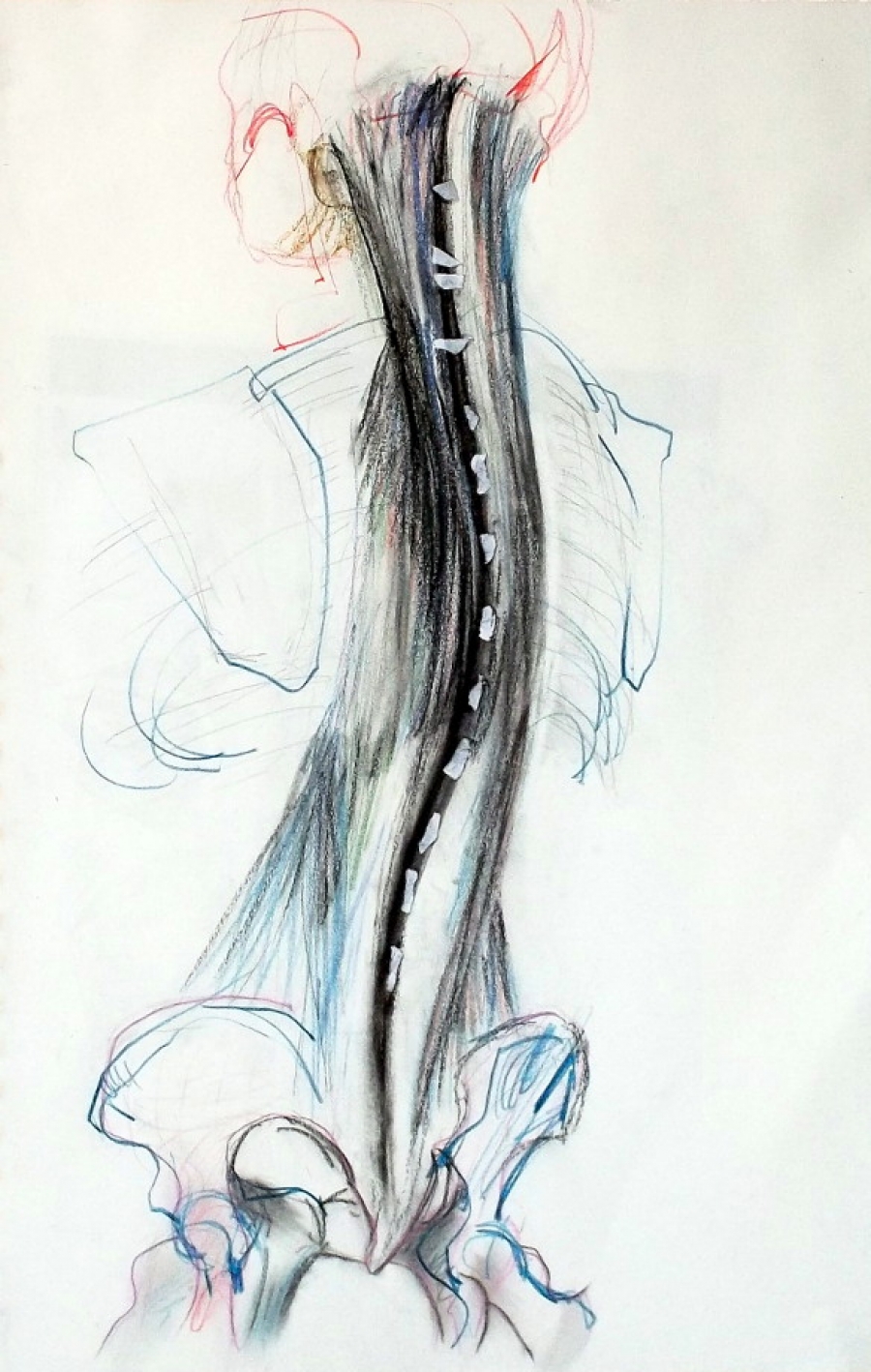
“Anatomy 9,” 28 x 42 cm
Which masters of art are you most inspired by? Are there any modern artists you look up to as well?
As way of proceeding I’m quite independent as I began as self taught, but I read some books along the years that inspired me a lot or that I identified with, especially “Drawing on the Right Side of the Brain” by Betty Edwards, “Concerning the spiritual in art” by Wassily Kandinsky and “Stroke by Stroke” by Henri Michaux. Then last winter I attended the Brera academy in Milan – I knew professors that are great artists also, and I got very inspired by them over all by Barbara Giorgis and Maria Tcholakova, so much that this year I will attend again.
When did you first think of the idea for your Stains series? What do the shapes you paint look like to you?
For the stains I got inspired and started by artist and professor Barbara Giorgis, then of course I developed them in my own way. I just play with colours and shapes and then I let the intuition work for me.
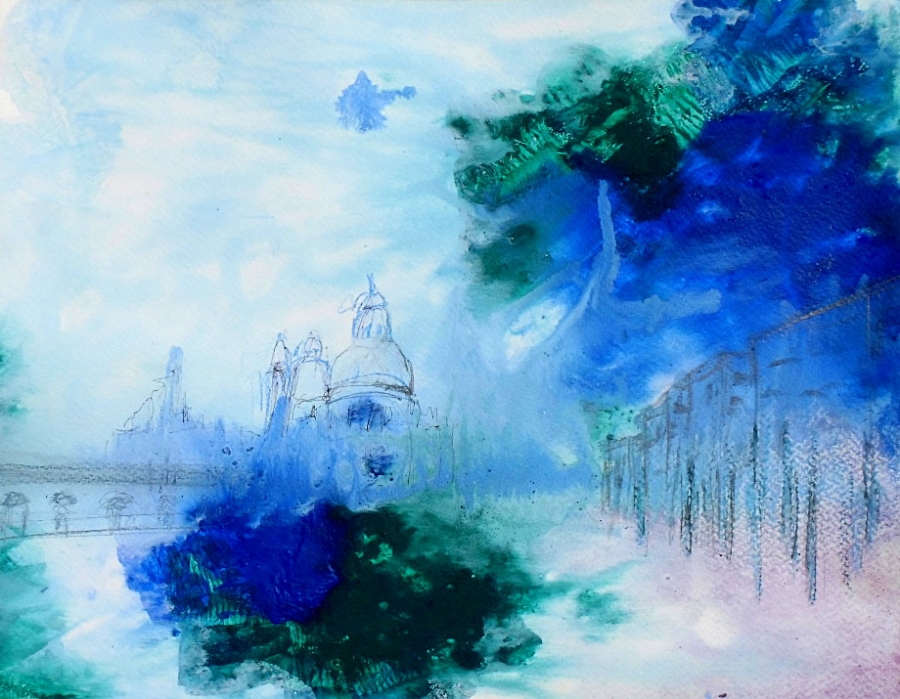
“Venice,” 25 x 35 cm
What’s your earliest memory of creating/painting/drawing?
My great-great father was a painter. He never taught me anything, but when as a child I went to visit, I always found a blank canvas and colors ready to be used in his studio. So without saying anything while the adults chat, I went to his studio and did a painting, it was like a mutually concealed understanding. He appreciated a lot even though he was not a man of many words. Later I stopped painting for many many years, until I started again when I lived in Brazil about at the age of 28, doing lots of collages with founded objects, and later adding on paint.
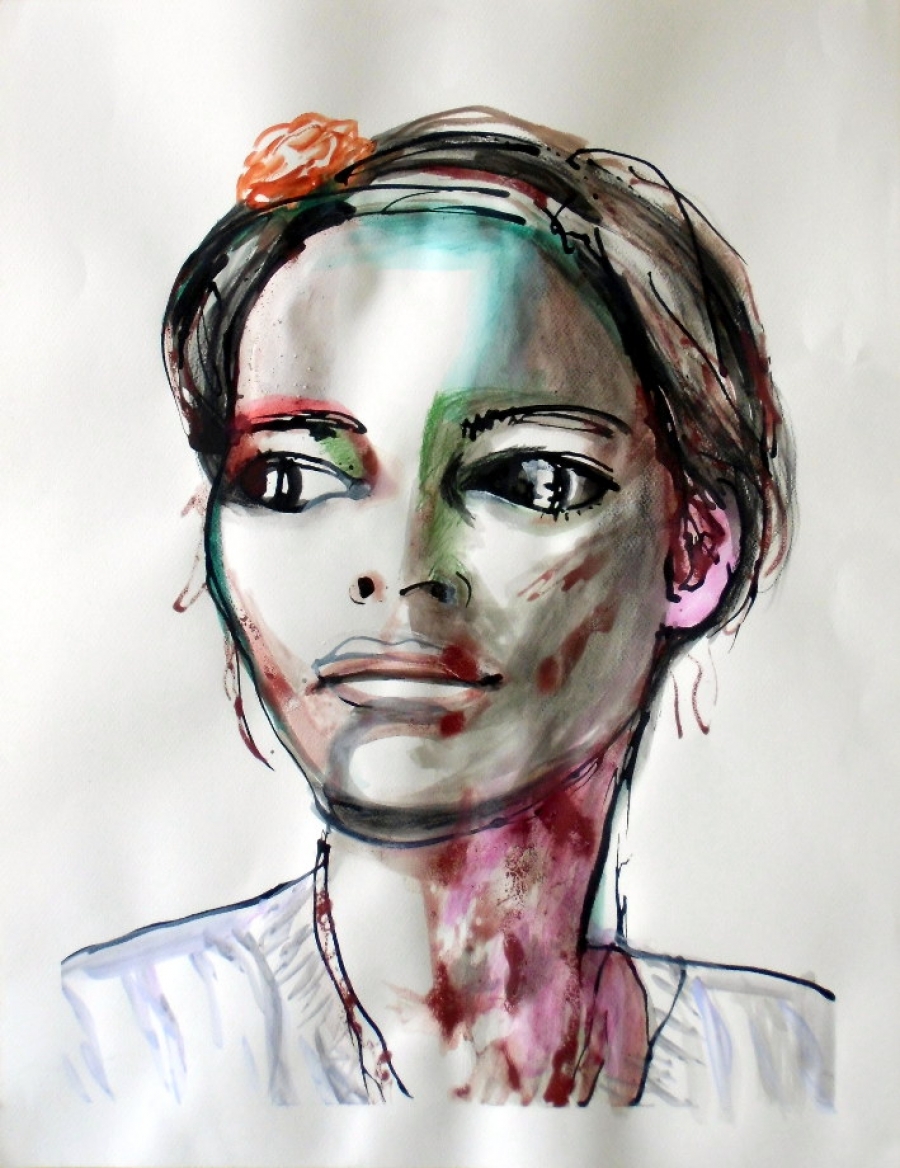
“Self portrait,” 50 x 65 cm
For more of Ilaria’s work, check out her website, and find her on Facebook and Twitter.






































